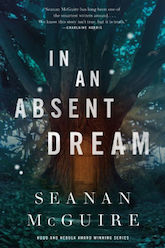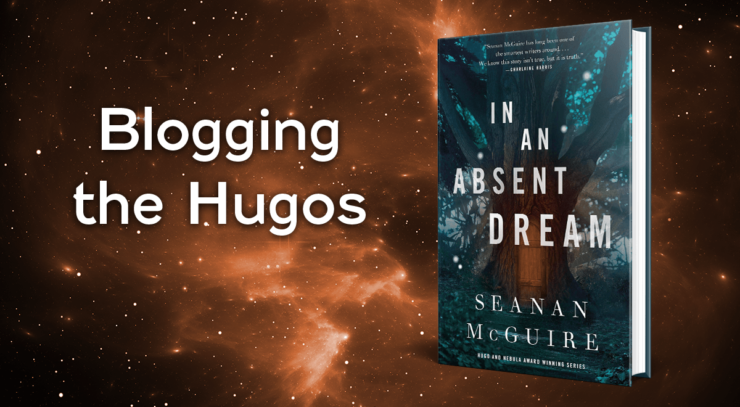In the lead-up to the 2020 Hugo Awards, we’re taking time to appreciate this year’s best novella Finalists, and what makes each of them great.
Seanan McGuire’s Wayward Children series is no stranger to the Hugos—the first three novellas have all been finalists in previous years, with the first book, Every Heart a Doorway, winning the 2017 Hugo Award for Best Novella.
The books are Hugo finalists for a simple reason—they’re very, very good. And the fourth installment, In an Absent Dream, is no exception. The series, which focuses on kids who have found magical doors to their perfect, fantastical worlds but then find themselves thrust back into our mundane reality, has rightfully captured the hearts of many an SFF reader.
If you haven’t had a chance to read the other novellas in the series yet, however, don’t fret—like the other Wayward Children books, you can read and enjoy In an Absent Dream as a standalone story. (My recommendation, however, would be to read the first in the series, Every Heart a Doorway, first. After that, all the other books stem out from that one, with certain characters from the first novella making their way into other stories.)
If you’ve read the first novella, you’re already familiar with In an Absent Dream’s protagonist, Lundy. In the first book, she is a peripheral character, a 60ish-year-old teacher at Eleanor West’s School for Wayward Children who finds herself in an 8-year-old’s body due to a certain mishap with her own magical world, the Goblin Market.
It’s not wrong to say that the 2020 Hugo-nominated novella is a prequel of the first Wayward Children book, a tale where we learn how Lundy ultimately found herself partnering with Eleanor West. But just calling In An Absent Dream a prequel does the story a disservice. The novella tells us Lundy’s origin story, yes, but it does more than that: It gives her deeper, darker dimensions and paints a portrait of someone who has lived a life and has faced the same challenges and choices that her Wayward Children students have.
Buy the Book


In An Absent Dream
And so we learn Lundy’s story, a tale that’s told in a lyrical cadence that evokes the feeling of a fairy tale. We start In an Absent Dream at the beginning of Lundy’s life, when she is just six years old. As a young child, she has no friends, in no small part because her father is the principal at her school. She accepts this role as a loner, however, the familiarity of solitude becoming a comfort to her more than a burden.
But then she turns eight and finds her magical door to the Goblin Market. It’s there that she meets another young girl named Moon as well as the Archivist, an adult who helps new visitors become acclimated to the rules of this brutal and fantastical world. It’s in the Market’s stalls and through the Archivist’s teachings where Lundy learns about fair value, about the harshness that comes with the strict rules those in this land must follow. And yet it is also here where Lundy comes into her own, a place where she truly fits in, and, through Moon, learns the love and pain that comes from deep friendship.
But all that comes later. We first spend time with Lundy as she goes back and forth between the Goblin Market and our world, still pulled between the two even though she’s confident in her desire to permanently stay with Moon and the Archivist once she turns 18 and the door closes forever. She faces pain and heartache in both worlds, however, both through the death of a friend in the Goblin Market and through her strife with her father, a man who once visited the very same world when he was a child and decidedly shut that door behind him when he became an adult.
Even through all the trials and adventures that Lundy faces—from fighting the Wasp Queen to escaping the boarding school her father banishes her to—In An Absent Dream remains a story about friendship and family, about the joy and the cost that both can bring.
And even if you know how the story will end, the final pages of this novella will still break your heart. This story, like all the others in this series, plucks a cord for those who feel they don’t quite fit or belong in our world. It’s the tragedy and beauty of the Wayward Children books that there are other worlds where kids can find a place where they belong, but, for whatever reason, aren’t allowed to stay. What they (and we) can do, however, is make friends with those who are similarly suffering in their own unique ways, and embrace and love them for who they are, not who the world says they should be. That’s the message the School of Wayward Children tries to teach its students, and it’s one we would all benefit from learning as well.
Vanessa Armstrong is a writer with bylines at The LA Times, SYFY WIRE, StarTrek.com and other publications. She lives in Los Angeles with her dog Penny and her husband Jon, and she loves books more than most things. You can find more of her work on her website or follow her on Twitter @vfarmstrong.










